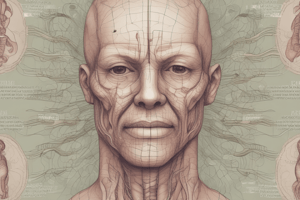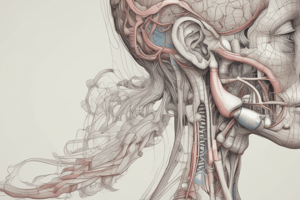Podcast
Questions and Answers
Which function is primarily associated with the respiratory system?
Which function is primarily associated with the respiratory system?
- Transporting nutrients to cells throughout the body.
- Filtering waste products from the blood.
- Overseeing gas exchange between the blood and the external environment. (correct)
- Regulating body temperature through sweat glands.
What critical process occurs within the alveoli of the lungs?
What critical process occurs within the alveoli of the lungs?
- Filtration of air to remove particulate matter.
- Exchange of gases between the air and the blood. (correct)
- Regulation of air temperature and humidity.
- Production of mucus to trap pathogens.
What roles do the passageways to the lungs perform on incoming air?
What roles do the passageways to the lungs perform on incoming air?
- Pressurizing, filtering, and cooling.
- Heating, humidifying, and purifying. (correct)
- Dehumidifying, cooling, and purifying.
- Cooling, drying, and filtering.
What is the first structure that air encounters as it enters the respiratory system?
What is the first structure that air encounters as it enters the respiratory system?
Which structure divides the nasal cavity into left and right portions?
Which structure divides the nasal cavity into left and right portions?
What is the role of mucus in the nasal cavity?
What is the role of mucus in the nasal cavity?
Where are the olfactory receptors, responsible for the sense of smell, located?
Where are the olfactory receptors, responsible for the sense of smell, located?
What is the purpose of the conchae in the nasal cavity?
What is the purpose of the conchae in the nasal cavity?
Which of the following describes the pharynx?
Which of the following describes the pharynx?
Which regions of the pharynx serve as a common passageway for both air and food?
Which regions of the pharynx serve as a common passageway for both air and food?
Where are the lingual tonsils located?
Where are the lingual tonsils located?
What is the primary function of the larynx?
What is the primary function of the larynx?
Which structure routes air into the trachea and food into the esophagus?
Which structure routes air into the trachea and food into the esophagus?
What is the function of the ciliated mucosa in the trachea?
What is the function of the ciliated mucosa in the trachea?
Why is the right primary bronchus more susceptible to collecting foreign debris compared to the left?
Why is the right primary bronchus more susceptible to collecting foreign debris compared to the left?
What are the structures in the respiratory zone?
What are the structures in the respiratory zone?
What type of epithelial tissue primarily forms the walls of the alveoli?
What type of epithelial tissue primarily forms the walls of the alveoli?
How does oxygen move from the alveoli into the blood?
How does oxygen move from the alveoli into the blood?
What is the role of macrophages in the alveoli?
What is the role of macrophages in the alveoli?
What does surfactant do within the alveoli?
What does surfactant do within the alveoli?
What occurs during inspiration?
What occurs during inspiration?
What happens to the size of the thoracic cavity during expiration?
What happens to the size of the thoracic cavity during expiration?
Where does external respiration occur?
Where does external respiration occur?
What is the main method of carbon dioxide transport in the blood?
What is the main method of carbon dioxide transport in the blood?
Flashcards
Respiratory System Function
Respiratory System Function
Oversees gas exchange between blood and the external environment.
Alveoli
Alveoli
Exchange of gases within the lungs happens here.
Nostrils
Nostrils
Air enters here.
Nasal Cavity
Nasal Cavity
Signup and view all the flashcards
Nasal Septum
Nasal Septum
Signup and view all the flashcards
Pharynx
Pharynx
Signup and view all the flashcards
Nasopharynx
Nasopharynx
Signup and view all the flashcards
Oropharynx
Oropharynx
Signup and view all the flashcards
Laryngopharynx
Laryngopharynx
Signup and view all the flashcards
Epiglottis
Epiglottis
Signup and view all the flashcards
Trachea
Trachea
Signup and view all the flashcards
Primary Bronchi
Primary Bronchi
Signup and view all the flashcards
Bronchiole
Bronchiole
Signup and view all the flashcards
Lungs
Lungs
Signup and view all the flashcards
Pulmonary (Visceral) Pleura
Pulmonary (Visceral) Pleura
Signup and view all the flashcards
Parietal Pleura
Parietal Pleura
Signup and view all the flashcards
Respiratory Zone
Respiratory Zone
Signup and view all the flashcards
Respiratory Membrane
Respiratory Membrane
Signup and view all the flashcards
Pulmonary Ventilation
Pulmonary Ventilation
Signup and view all the flashcards
Inspiration
Inspiration
Signup and view all the flashcards
Expiration
Expiration
Signup and view all the flashcards
External Respiration
External Respiration
Signup and view all the flashcards
Respiratory Gas Transport
Respiratory Gas Transport
Signup and view all the flashcards
Internal Respiration
Internal Respiration
Signup and view all the flashcards
Tidal Volume (TV)
Tidal Volume (TV)
Signup and view all the flashcards
Study Notes
- The respiratory system oversees gas exchanges between the blood and the external environment.
- Gases exchange in the alveoli within the lungs.
- Passageways purify, warm, and humidify air going to the lungs.
Air Pathway
- Air enters the nose through the nostrils.
- Air enters the nasal cavity, which the nasal septum divides.
- Mucus lines the nasal cavity, which moistens, warms, and traps debris.
- The olfactory (smell) receptors are located on the cavity's superior surface
- Walls have fleshy projection called conchae to increase surface area.
- The pharynx is a muscular passage from the nasal cavity to the larynx.
- Three regions of the Pharynx:
- The nasopharynx is the superior region behind the nasal cavity.
- The oropharynx is the middle region behind the mouth.
- The laryngopharynx is the inferior region attached to the larynx.
- The oropharynx and laryngopharynx are common passageways for air and food.
- Tonsils (clusters of lymphatic tissue) of the pharynx include:
- Pharyngeal tonsils (adenoids) in the nasopharynx.
- Palatine tonsils in the oropharynx.
- Lingual tonsils at the base of the tongue.
- The larynx or voice box protrudes anteriorly (Adam's apple).
- The superior glottis (lumen or opening of the larynx) has an epiglottis.
- Epiglottis routes air into the trachea and food into the esophagus.
- The Larynx contains vocal cords and plays a role in speech.
- The trachea is the windpipe, which connects the larynx with the bronchi.
- The Trachea is lined with ciliated mucosa.
- Ciliated mucosa beats continuously in the opposite direction of incoming air.
- Ciliated mucosa expels mucus loaded with dust and other debris away from the lungs.
- The trachea's walls are reinforced with C-shaped hyaline cartilage rings.
- Primary bronchi is formed by the division of the trachea.
- The bronchi enter the lung.
- The right bronchus is wider (larger), shorter, and straighter than the left and collects more foreign debris.
- Bronchi subdivide into smaller and smaller branches:
- Secondary bronchi
- Tertiary bronchi
- The bronchiole is the smallest branch of the bronchi.
- Terminal bronchiole.
Lungs
- Lungs occupy most of the thoracic cavity.
- The apex is near the clavicle, the superior portion.
- The base rests on the diaphragm, the inferior portion.
- Each lung is divided into lobes by fissures.
- The left lung has two lobes.
- The right lung has three lobes.
- Coverings of the lungs:
- Pulmonary (visceral) pleura covers the lung surface.
- Parietal pleura lines the walls of the thoracic cavity.
- Pleural fluid fills the area between the layers of pleura to allow gliding.
Respiratory Zone in the Lungs
- The respiratory zone includes the respiratory bronchiole, alveolar duct, and alveoli.
- Gas exchange occurs within the alveoli in the respiratory membrane.
- A thin squamous epithelial layer lines alveolar walls.
- Pulmonary capillaries cover the external surfaces of alveoli.
- Gas crosses the respiratory membrane of the alveoli by diffusion (movement of materials from higher to lower concentration).
- Oxygen enters the blood from the alveoli.
- Carbon dioxide enters the alveoli from the blood.
- Macrophages add protection.
- Surfactant coats gas-exposed alveolar surfaces to keep them from collapsing after exhalation.
Events of Respiration
- Pulmonary ventilation moves air in and out of the lungs; it has two phases.
- Inspiration: Flow of air into the lung.
- The diaphragm and intercostal muscles contract.
- The size of the thoracic cavity increases.
- External air enters the lungs due to a drop in pressure inside the thoracic cavity caused by increased size.
- Expiration: Air leaving the lung.
- As muscles (diaphragm and intercostal muscles) relax, the size of the thoracic cavity decreases.
- The decreased size builds pressure in the cavity, which pushes out the air.
- External respiration exchanges gas between pulmonary blood and alveoli in the lungs.
- Oxygen movement: The alveoli always has more oxygen than the blood, therefore oxygen diffuses into the capillary blood.
- Carbon dioxide movement: Blood returning from tissues has higher concentrations of carbon dioxide than air in the alveoli, therefore CO₂ diffuses into alveoli.
- Respiratory gas transport: Oxygen and carbon dioxide transport via the bloodstream.
- Oxygen transport: Travels inside red blood cells attached to hemoglobin (oxyhemoglobin [HbO₂]); a small amount is carried in the plasma.
- Carbon dioxide transport: Most is transported in the plasma as bicarbonate ion (HCO₃-); a small amount is carried inside red blood cells on hemoglobin but at different binding sites than those of oxygen.
- Internal respiration exchanges gas between blood and body cells away from the lungs.
- Carbon dioxide diffuses out of tissue to blood, but oxygen diffuses from blood into tissue.
Respiratory Volumes and Capacities
- Respiratory capacity is affected by a person's size, sex, age, and physical condition.
- Tidal Volume (TV): Normal breathing moves about 500 ml of air with each breath.
- Residual volume of air: After exhalation, about 1200 ml of air remains in the lungs.
- Dead space volume: Air that remains in the conducting zone and never reaches alveoli for gas exchange.
- Inspiratory reserve volume (IRV): Amount of air that can be taken in forcibly over the tidal volume, which is usually between 2100 and 3200 ml.
- Expiratory reserve volume (ERV): Amount of air that can be forcibly exhaled that is approximately 1200 ml.
- Vital capacity: The total amount of exchangeable air when Votal capacity = TV + IRV + ERV.
- Respiratory capacities are measured with a spirometer.
Respiratory Sounds
- Sounds are monitored with a stethoscope.
- Bronchial sounds are produced by air rushing through the trachea and bronchi.
- Vesicular breathing sounds are soft sounds of air filling the alveoli.
Studying That Suits You
Use AI to generate personalized quizzes and flashcards to suit your learning preferences.




